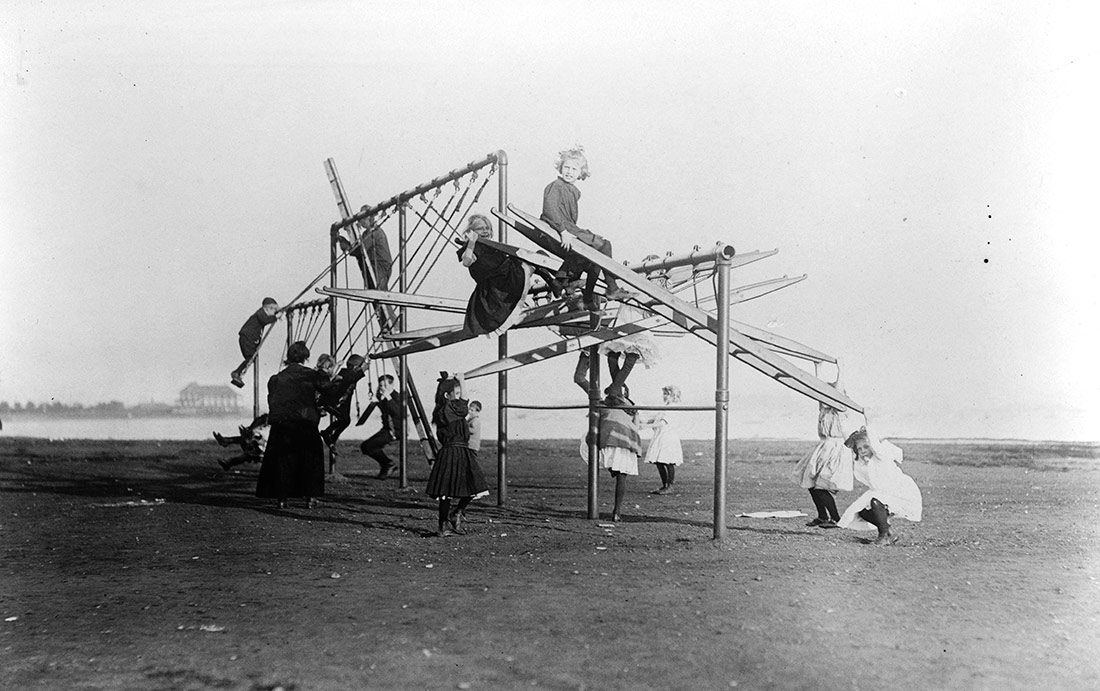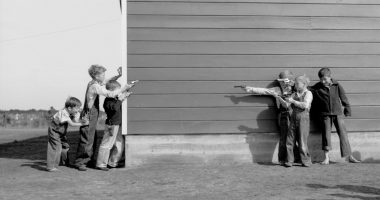
The dumps turned into a children’s play ground. Boston, 1909 | Lewis Wickes Hine, Library of Congress | Public Domain
In February 2020 at the CCCB we opened the doors of “Zooom”, a playable space that placed the focus on the act itself of playing. A selection of videogames differing from the usual assortment were presented, with the intention of representing different ways of experiencing the videogaming world. Based on this experience, its curators are offering here some tips for videogaming at home, with young children or as a family, whether for general entertainment or a moment of introspection.
When the doors of “Zooom” opened for the first time on 1 February 2020, its innocent pink carpet and its twenty games hid a clearly political intentionality. And the fact is that, if as Miguel Sicart (Play Matters, MIT Press, 2014) says: “[play is] a way of understanding what surrounds us” and of “being in the world”, then constructing a free and gratis public space, whose main intention was to build bridges within social plurality so that people felt their right to belong to and enjoy the videogame culture, then it would be ridiculous to deny its evident humanist militancy.
The way in which “Zooom” aimed to give form to its exercising of the universalisation of the game culture stemmed from its propositional heterogeneity. If everyone has a right to appropriate videogaming recreation in order to “be in the world”, the room should communicate that – in contrast with the generalised perception – games have much more to offer to collective enjoyment than the frenetic simulation of battlefields, whether these be of the literal warfare type, metaphorically epic or commercially sports-oriented. Playing is much more than that, and “Zooom” believed it to be so. For this reason, from the ideological manifesto that welcomed visitors at the entrance, it aimed to make clear that it had been set up to connect the artistic plurality of the medium with the human plurality willing to experience it. The room was for all of you, not matter what your age, no matter where you came from.
We wanted this radical heterogeneity to impregnate each of the layers that made up “Zooom”. The twenty games selected to populate it showed diversity in all of their communicative layers. But over and above the games and their intentions, at all times “Zooom” aimed to defend the experiential plurality that they could generate. The important thing was not the works themselves, but the possible ways of being with them. We wanted to show that playing is much more than an exercise in manipulative execution with which to hit predetermined targets and, for that reason, we organised the space into areas that represented the diversity of its nature. Playing means contemplating the preciousness of the seasonality of the cosmos; it means modifying, for our pleasure, the audiovisual horizon and dancing with the result; it means conversing about a discursive ambiguity and looking in depth at our feelings; it means understanding frustration as a collective feeling and not as individual guilt; it means laughing at what we are, while being other things, with other people…. In short, “it is a way of explaining the world, of explaining it to others and to ourselves” (ibid.), and that world and those people who inhabit it are anything but a single, homogenous and immutable thing, therein lies the beauty of it all.
“Zooom” was forced to close on 13 March because a virus decided to confine us all to our homes and, with this, also confined were all the devices that we had designed so that the show not only welcomed you as visitors but made you feel at home as players. The most important thing of all, however, did survive: the discourse that says that playing is an act of carnivalesque appropriation, capable of transforming the surrounding context, and that games are perfectly capable of achieving this thanks to their proven contemporary plurality; all that is needed is bravery for getting to know them. For this reason, we are proposing that you allow the coloured carpet that zigzagged across the floors of “Zooom” to rebel against the lockdown, to break down the walls that are isolating it within the empty rooms at the CCCB and allow it to seep into your homes through this small adaptation of its spirit. Let us tell you how we can dress the technology that is asphyxiating us to convert it into a space for fictional introspection, into a canvas of shared interpretation or even into a mode of collective rebellion. If videogames can detonate these experiences, let us be your dynamite.
Coming together in play
In the last paragraph of Play Matters, made up of a single phrase and as a finishing touch to his entire game theory, Sicart needs only thirteen words to frame why it is so important for us to play: “Play gives us the world, and through play we make the world ours”. In these cold days in which all of our times seem to have been compressed into a kind of dense treacle that distances us from the here and now, playing can be a good tool for the reconquering of our most immediate environments. The videogame can be a bonfire around which we meet and demolish the possible hierarchies and attitudes that we have uncomfortably fossilised while we experience under its light and heat this experiential heterogeneity that converted that room at the CCCB into a place of exploration, curiosity and discovery. Playing, based on the prior agreement of the collective encounter, whether to globally assault the other side of the screen or so that what exists on that other side is poured out into the shared territory of our homes, serving us on a tray that dual possibility of offering us the world once more so that we can make it our own again. By playing we continue to exist and we continue to be present.
Almost as an act of insurrection from confined domesticity, play is also the perfect tool for the progressive claiming of times and spaces that until recently we took for granted, to re-knit the bones of our rituals and routines. Before the saturation that can emerge from the act of seeing ourselves constantly tangled up with our homes, we can dare with some of the impossible kitchens in Overcooked, harmoniously plunging into the catharsis of its playful stress and its way of dismantling everything that we thought we knew, whether leading a team of chefs or putting together a simple hamburger. Or we can erase our history of sapience and join the democratic party of uselessness of the Realistic Summer Sports Simulator, where sports become a celebration of clumsiness and ridicule; as clumsy and ridiculous as we have all been on that first day that we arrived at the videogame.
However, as we noted previously, not everything has to remain on the other side of the screens; we can open them up like windows so that play appropriates our space-times and transforms them from the top down into other places and other moments. A simple telephone with Bounden can disguise a living room as a dance floor; taking out mobiles is enough for a balcony to become the control deck of a spaceship that is advancing on a fixed course towards nonsense in Spaceteam; put Panoramical on the telly and the speakers can bring us back our Saturday nights, our post-work Fridays, our Thridays. Ultimately, playing together is not always a question of symmetry and understanding, sometimes it is totally the opposite: laughing because we do not understand, tripping over our feet and hands as we dance and even getting frustrated because the pizzas burn while we lose all our tips. May fire inspire.
Wrapping ourselves in games
The aim of “Zooom” to be a place for socialisation flourished in all of its corners in very diverse ways. Together with those corners that contained works whose explicit condition was that of participating with more than one pair of hands, there were also spaces in which playing meant sharing glances, music, poufs on the floor, tables with cushions or leftovers from the sampling of the different works. The enjoyment of its twenty videogames could come from their direct manipulation, but also from sitting in the co-pilot’s seat to watch another person play, shoulder to shoulder in front of a tablet. Today, confinement at home has only served to fan the flames of our desire to share, to cut distances, to socialise more than ever. Being in company as we face dialogue with these videogames means building bridges where we can be found watering our little parcels of shared existence.
This is something that can make an even deeper impression if we put it against the backlight of these days in which our sense of touch is on the run. Getting close to each other to play becomes almost a rebel act that can be put into practice from the sofa, sharing a tablet with the jokes of Chuchel or the microcosms of Hidden Folks and discovering the numerous ways in which these works react as our fingers approach the device. It can also be done as a spectrum of possibilities and encounters based on the joint negotiation of the act of playing, of deciding through agreement on how to navigate the database of Telling Lies and all of its lies, or discussing to resolve who is who in the pirate tragedy of The Return of the Obra Dinn, discovering each time a different colour in that rainbow that is co-piloting the play experience.
And, of course, under this blanket there is also room for that time that follows the tackling of games, that place where we meet up to read the leftovers that they have left behind for us. The socialisation of something such as the duo Kids/Plug&Play and its discourses on human relations or the web of connections that ties up the cosmic fabric of Gorogoa does not have to finish when we get to the credits, but can continue in that conversation a posteriori in which we comment on the what, how and who of when we played the game. Something that, deep down, is no more than another way of destroying barriers, of looking at each other and of practising the contrary to that inoculated social distancing in these times of drifting. Of opening our arms.
Feathering our nest with games
When we say that videogames represent terrains for the exploration and knowledge of the world around us, we also affirm this given their magical possibility of existing as a fictional space in which to exist, of becoming that place that emerges from the interrelation between our individual experiences as people and those offered by the “pretty lies” that emerge from poetry and narrative; in short, of being that third experiential translucid space into which we project ourselves and that affords us the possibility of transcending the thick walls of our routine reality so that we can feel “the lives of others”.
We understand the fears that “the general state of things” has created among us when considering videogames as a safe place in which to take refuge. However, over the course of the text we have been seeing that, far from being that tangle of freneticism that the industry aims to project on a grand scale, games have the capacity, as all pretty lies do, of being anything that they propose. For this reason, we believe it is also necessary to defend the act of individual play as an experience that is not only possible but really important among all of those that the medium offers us. We must permit the videogame to erect for us these frontiers of introspective refuge that only culture is capable of constructing, and take advantage of its particular ways of counting.
All in all, it may be that we perceive as alien the path through the forest until we reach that homely nest, that we get lost in it, or simply it is shown to us as something impossible or not at all desirable for travelling. It may be that, for example, it makes us afraid or feel guilty shame for allowing our 5-year-old to autonomously enjoy a while in front of the screen. But this guiltiness is perhaps determined more by the type of works that are usually consumed by following them than by the fact of playing with a delight of a work such as Metamorphabet, the lyrical alphabet by Patrick Smith that enables us to flow and float between its ideas as we play with it; let’s allow them to do it. And if our child is a little older, why not let them explore the overwhelming preciousness of the worlds of Samorost 3, the adventure created by Amanita Design that enables us to be an astronaut gnome with a desire to stroll around, enjoy and understand the places visited and the people who inhabit them. In fact, let’s dare to take advantage of this time of independence created for their autonomous enjoyment and thus be able to see through the window, listen to a little music, read a book or, surprise surprise, play on our own for a while. The magnificent offering of games will enable us, among many other things, to satisfy our misanthropic urges to the beat of jazz and blood with the angry gorilla of Ape Out, manage our existential fears with the space odyssey of Orchids to Dusk, by Pol Clarissou, or be enthralled by the complex allegory of the dramatic consequences of late capitalism that is Kentucky Route Zero by Cardboard Computer.
Although there is usually insistence on games urgently needing to implement processes of accompaniment for their cultural universalisation – on all levels – the selection of good works with which to enjoy and generate individual enjoyment is one of the actions with the greatest relevance and transcendence within any exercise of mediation. Showing the plural possibilities of pleasure unknown achieves the multiplication and complexification of ways of relating with culture, and that interpretational and heterogeneity growth of fruition can only generate positive results.
And now we encourage you to play and, as we have tried to do with you, to try to seduce the people around you to play: to play alone, to play with you, to play with each other… Dare to try out new games, discard the ones that bore you, express to the full the ones that you love, share with the world the resulting experiences, the readings made, the frustrations felt. Let play form part of your cultural ecosystem: let its transformational carnival light up new corners of your home. Perhaps in these days that we are living through, we need it more than ever.





Leave a comment